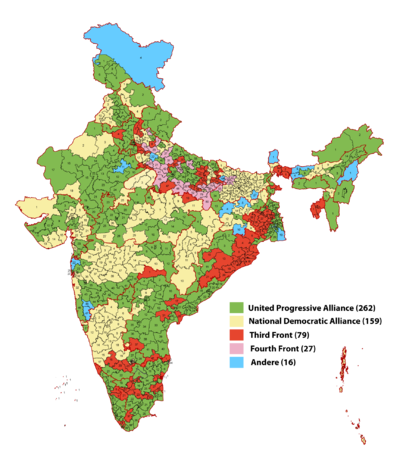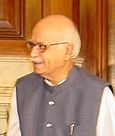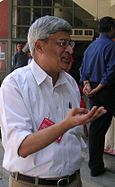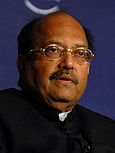- Parlamentswahlen in Indien 2009
-
Bei den Parlamentswahlen in Indien 2009 wurde das Unterhaus für das gesamtindische Parlament, die Lok Sabha gewählt. Die Wahlen fanden nicht an einem einzigen Tag, sondern verteilt über 5 Wahltermine, am 16., 22./23. und 30. April, sowie am 7. und 13. Mai 2009, statt. Dies hatte vor allem organisatorische Gründe. Alle Wahlergebnisse wurden jedoch erst am 16. Mai 2009 bekanntgegeben[1]. Wahlberechtigt waren 713,8 Millionen Menschen.[2] Indien sieht sich selbst als „größte Demokratie der Welt“ und die Wahlen wurden dementsprechend als die größte demokratische Wahlentscheidung der Welt gesehen.[3]
Als Gewinner aus der Wahl ging die United Progressive Alliance (UPA), ein Parteienbündnis unter Führung des Indischen Nationalkongresses hervor, das 262 der 543 Sitze (48,3 %) gewann. Besonders unerwartet war das gute Abschneiden der UPA in den Bundesstaaten Uttar Pradesh, Westbengalen, Kerala, Tamil Nadu und Rajasthan. Die von der hinduistischen Bharatiya Janata Party (BJP) angeführte National Democratic Alliance (NDA) kam auf 159 Sitze (29,3%). Überraschend war auch das relativ schlechte Abschneiden der in dem Wahlbündnis der Third Front zusammengeschlossenen Linksparteien (79 Sitze, 14,5%). Die globale Wahlbeteiligung lag bei 59,7% (450,8 Millionen Wähler) und unter den gewählten Abgeordneten befinden sich 60 Frauen (11,0%).[2] Damit hat die bisherige Regierung unter Führung Premierministers Manmohan Singh ihren bisherigen parlamentarischen Rückhalt deutlich ausbauen können. In einer ersten kurzen Ansprache nach der Wahl dankte Premierministers Singh den Wählern für das Vertrauen, das sie in die Kongresspartei gesetzt hatten. Er versprach eine sozial handelnde Regierung („a caring government“) und eine Politik der nachhaltigen und gerechten wirtschaftlichen Entwicklung („sustained and equitable development“). Die Regierung würde weiter die säkulare Gesellschaftsordnung schützen und für eine Gesellschaft ohne Hass eintreten.[4] Insbesondere die letzte Bemerkung war eine klare Absage an hindu-nationalistisches und (in geringerem Maße) radikal-muslimisches Gedankengut, aber auch an klassenkämpferische Parolen, wie sie von einem Teil der Oppositionsparteien vertreten worden waren.
Zeitgleich zu den Wahlen zum gesamtstaatlichen Parlament fanden auch Wahlen zu den Parlamenten der drei Bundesstaaten Andhra Pradesh, Orissa und Sikkim statt.
Inhaltsverzeichnis
Wahlrecht und Wahlmodus
Die Wahl fand nach dem einfachen Mehrheitswahlrecht in 543 einzelnen Wahlkreisen statt. Da die Mehrheitsverhältnisse in den meisten Wahlkreisen nicht eindeutig waren haben sich vor den Wahlen Bündnisse und Allianzen aus verschiedenen Parteien gebildet, die sich untereinander auf gemeinsame Kandidaten für einzelne Wahlkreise geeinigt haben. Die Stimmen wurden in insgesamt 828.804 einzelnen Wahllokalen an elektronischen Wahlmaschinen abgegeben[5][6]. Die Wähler konnten dabei per Knopfdruck nicht nur Namen, sondern auch Bild und Symbol ihres Kandidaten wählen. So sollte zum einen eine rasche Auswertung der Stimmergebnisse gewährleistet werden, zum andern sollte garantiert sein, dass auch die mehr als 100 Millionen Analphabeten im Land korrekt wählen können. Insgesamt verlief die Wahl und die Auszählung der Stimmen bemerkenswert reibungslos.
Parteien und Allianzen
Die Wahlen wurden durch 4 große Parteienbündnisse geprägt. Da in den Wahlkreisen das Mehrheitswahlrecht gilt, sind bei den indischen Wahlen Wahlkreis-Kandidatenabsprachen gang und gäbe.
United Progressive Alliance (UPA)
Die United Progressive Alliance ist eine Parteienallianz unter Führung des Indischen Nationalkongresses. Die (UPA) war nach den Parlamentswahlen 2004 gegründet worden und umfasste bei der jetzigen Wahl die folgenden Parteien: Dravida Munnetra Kazhagam (eine südindische Regionalpartei in Tamil Nadu), die Nationalist Congress Party (ganz überwiegend in Maharashtra), Jharkhand Mukti Morcha (in Jharkhand, All India Trinamool Congress (eine Abspaltung der Kongresspartei in Westbengalen), Jammu & Kashmir National Conference (eine Regionalpartei in Jammu und Kashmir), sowie einige kleinere Regionalparteien. Die Rashtriya Janata Dal (RJD) hatte dagegen die UPA-Allianz verlassen und sich der sogenannten Forth Front angeschlossen. Spitzenkandidat für das Amt des Premierministers war der amtierende Premierminister Manmohan Singh, Vorsitzende der UPA war Sonia Gandhi, die Witwe des ehemaligen Premierministers Rajiv Gandhi.
Nationale Demokratische Allianz
Die Nationale Demokratische Allianz (National Democratic Alliance) (NDA) ist ein Parteienbündnis unter Führung der hinduistisch-nationalistischen Bharatiya Janata Party (BJP). Die nach der BJP wichtigste Parteien sind Shiv Sena (Regionalpartei aus Maharashtra), sowie Janata Dal, die in den Bundesstaaten Bihar and Karnataka ihre Schwerpunkte hat, Rashtriya Lok Dal in Uttar Pradesh, sowie Shiromani Akali Dal, eine Sikh-Partei aus dem Punjab. Im Vorfeld der Wahlen waren einige ehemalige Bündnispartner ausgeschert und in andere Lager gewechselt, so All India Trinamool Congress in das Lager der UPA und Biju Janata Dal sowie All India Anna Dravida Munnetra Kazhagam in das Lager der Third Front. Spitzenkandidat der NDA war der 81jährige Lal Krishna Advani von der BJP.
Third Front
Die Third Front bildete ein heterogenes Bündnis aus Parteien des linken Spektrums, die sowohl gegen die kongressgeführte Regierung als auch gegen die BJP-geführte Opposition auftraten. Dazu gehören die Parteien der Left Front ("Linksfront"). Es handelte sich um eine Allianz aus mehr als 10 verschiedenen politischen Parteien, die das politisch linke Spektrum abdecken. Hierzu gehören neben der Bahujan Samaj Party (überwiegend in Uttar Pradesh), der Vertreterin der immer noch in vielen Dingen benachteiligten unteren Kasten, die Kommunistischen Parteien Indiens (Communist Party of India und Communist Party of India (Marxist)), die ihre politischen Schwerpunkte in Westbengalen, Kerala und Tripura haben und Biju Janata Dal in Orissa.
Fourth Front
Die Forth Front bildete einen Zusammenschluss einiger Parteien, die keiner der o.g. Bündnisse angehören. Dazu gehörten die Parteien Rashtriya Janata Dal (RJD) und Lok Janshakti Party (LJP), beide mit Schwerpunkt in Orissa, die früher zum UPA-Parteienbündnis gehört hatten. Hinzu kam die hauptsächlich in Uttar Pradesh beheimatete Samajwadi Party (SP), die früher ebenfalls die UPA-Allianz zumindest von außen unterstützt hatte.
Zeitlicher Ablauf der Wahlen
Durch den obersten Wahlleiter, den Chief Election Commissioner of India N. Gopalaswami wurden am 2. März 2009 die folgenden Wahltermine festgelegt:[2]
- 16. April - Andhra Pradesh, Arunachal Pradesh, Assam, Bihar, Jammu und Kashmir, Kerala, Maharashtra, Manipur, Meghalaya, Mizoram, Nagaland, Orissa, Uttar Pradesh, Chhattisgarh, Jharkhand, Andamanen und Nikobaren, Lakshadweep
- 22. April - Manipur
- 23. April - Andhra Pradesh, Assam, Bihar, Goa, Jammu und Kashmir, Karnataka, Madhya Pradesh, Maharashtra, Orissa, Tripura, Uttar Pradesh, Jharkhand
- 30. April - Bihar, Gujarat, Jammu und Kashmir, Karnataka, Madhya Pradesh, Maharashtra, Sikkim, Uttar Pradesh, Westbengalen, Dadra und Nagar Haveli, Daman und Diu
- 7. Mai - Bihar, Haryana, Jammu und Kashmir, Punjab, Rajasthan, Uttar Pradesh, Westbengalen, Delhi
- 13. Mai - Himachal Pradesh, Jammu und Kashmir, Punjab, Tamil Nadu, Uttar Pradesh, Westbengalen, Uttarakhand, Chandigarh, Puducherry
Wahlen in den einzelnen Bundesstaaten und Unionsterritorien Staaten und
UnionsterritorienWahl-
kreiseWahl-
terminePhase 1 Phase 2 Phase 3 Phase 4 Phase 5 Wahl-
beteiligung
im Mittel16.
Apr.Wahl-
beteiligung[7]22./23.
Apr.Wahl-
beteiligung[7]30.
Apr.Wahl-
beteiligung[8]7.
MaiWahl-
beteiligung[9]13.
MaiWahl-
beteiligung[10]Andamanen und Nikobaren 1 1 1 64.15% - - - - 64.15% Andhra Pradesh 42 2 22 69.75% 20 75.50% - - - 72.40% Arunachal Pradesh 2 1 2 65.00% - - - - 65.00% Assam 14 2 3 67.61% 11 70.06% - - - 69.68% Bihar 40 4 13 43.21% 13 45.83% 11 46.12% 3 37.00% - 44.27% Chandigarh 1 1 - - - - 1 65.51% 65.51% Chhattisgarh 11 1 11 58.19% - - - - 58.19% Dadra und Nagar Haveli 1 1 - - 1 73.22% - - 73.22% Daman und Diu 1 1 - - 1 71.85% - - 71.85% Delhi 7 1 - - - 7 51.79% - 51.79% Goa 2 1 - 2 55.42% - - - 55.42% Gujarat 26 1 - - 26 47.92% - - 47.92% Haryana 10 1 - - - 10 67.67% - 67.67% Himachal Pradesh 4 1 - - - - 4 58.35% 58.35% Jammu und Kashmir 6 5 1 49.68% 1 44.73% 1 26.43% 1 25.38% 2 45.63% 39.66% Jharkhand 14 2 6 51.16% 8 48.86% - - - 49.77% Karnataka 28 2 - 17 60.00% 11 58.48% - - 59.44% Kerala 20 1 20 73.33% - - - - 73.33% Lakshadweep 1 1 1 86.10% - - - - 86.10% Madhya Pradesh 29 2 - 13 51.39% 16 51.22% - - 51.30% Maharashtra 48 3 13 55.74% 25 49.18% 10 41.24% - - 49.17% Manipur 2 2 1 83.70% 1 75.50% - - - 79.80% Meghalaya 2 1 2 64.40% - - - - 64.40% Mizoram 1 1 1 50.93% - - - - 50.93% Nagaland 1 1 1 90.21% - - - - 90.21% Orissa 21 2 10 64.90% 11 62.00% - - - 63.35% Puducherry 1 1 - - - - 1 79.70% 79.70% Punjab 13 2 - - - 4 72.78% 9 68.13% 69.58% Rajasthan 25 1 - - - 25 48.50% - 48.50% Sikkim 1 1 - - 1 82.00% - - 82.00% Tamil Nadu 39 1 - - - - 39 72.46% 72.46% Tripura 2 1 - 2 83.91% - - - 83.91% Uttar Pradesh 80 5 16 45.37% 17 45.48% 15 46.12% 18 48.00% 14 47.55% 46.45% Uttarakhand 5 1 - - - - 5 53.67% 53.67% Westbengalen 42 3 - - 14 80.71% 17 82.60% 11 76.30% 78.93% Wahlkreise gesamt 543 124 59.07% 141 56.66% 107 52.12% 85 52.32% 86 65.74% 56.97% Staaten/Unionsterritorien, in denen gewählt wurde 17 13 11 8 9 Staaten/Unionsterritorien Wahlkreise Bundesstaaten und Unionsterritorien mit einem Wahltermin 22 164 Bundesstaaten und Unionsterritorien mit 2 Wahlterminen 8 163 Bundesstaaten und Unionsterritorien mit 3 Wahlterminen 2 90 Bundesstaaten und Unionsterritorien mit 4 Wahlterminen 1 40 Bundesstaaten und Unionsterritorien mit 5 Wahlterminen 2 86 Gesamt 35 543 Quelle: Election Commission of India[1] Ergebnisse
Ergebnisse nach Parteienbündnissen
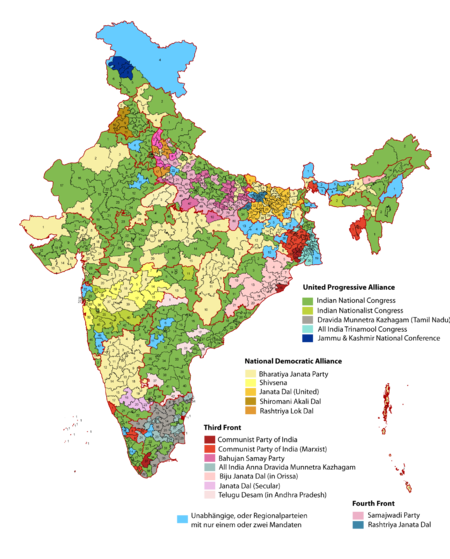 Ergebnis nach Wahlkreisen und Parteien (die meisten Parteien haben nur in jeweils einem oder zwei Bundesstaaten Mandate gewonnen, diese sind dann in Klammern vermerkt):[2]
Ergebnis nach Wahlkreisen und Parteien (die meisten Parteien haben nur in jeweils einem oder zwei Bundesstaaten Mandate gewonnen, diese sind dann in Klammern vermerkt):[2]
1. United Progressive Alliance- Indischer Nationalkongress
- Dravida Munnetra Kazhagam (in Tamil Nadu)
- Nationalist Congress Party (Maharashtra und Meghalaya)
- All India Trinamool Congress (in Westbengalen)
- Jammu & Kashmir National Conference (in Jammu und Kashmir)
2. National Democratic Alliance- Bharatiya Janata Party
- Janata Dal (United) (in Bihar)
- Shiv Sena (in Maharashtra)
- Rashtriya Lok Dal (in Uttar Pradesh)
- Shiromani Akali Dal (im Punjab)
3. Third Front- Communist Party of India (Marxist)
- Kommunistische Partei Indiens
- Bahujan Samaj Party (in Madhya Pradesh und Uttar Pradesh
- Biju Janata Dal (in Orissa)
- All India Anna Dravida Munnetra Kazhagam (in Tamil Nadu)
- Telugu Desam Party (in Andhra Pradesh)
- Janata Dal (Secular) (in Karnataka)
4. Fourth Front- Samajwadi Party (in Uttar Pradesh)
- Rashtriya Janata Dal in Bihar
5. Unabhängige Kandidaten oder Regionalparteien mit nur einem oder zwei Mandaten- Andere (unter diesen befinden sich auch einige, die den o.g. Koalitionen angehören)
Allianzen Partei Sitze Änderung United
Progressive
Alliance
Sitze: 262
Änderung: +80Indischer Nationalkongress 206 +61 Dravida Munnetra Kazhagam 18 +2 Nationalist Congress Party 9 ±0 All India Trinamool Congress 19 +17 Jammu & Kashmir National Conference 3 +1 Jharkhand Mukti Morcha 2 -3 All India Majlis-e-Ittehadul Muslimeen 1 ±0 Indian Union Muslim League 2 +1 Kerala Congress (Mani) 1 +1 Assam United Democratic Front 1 +1 National
Democratic
Alliance
Sitze: 159
Änderung: -17Bharatiya Janata Party 116 -22 Janata Dal (United) 20 +12 Shiv Sena 11 -1 Rashtriya Lok Dal 5 +2 Shiromani Akali Dal 4 -4 Asom Gana Parishad 1 -1 Telangana Rashtra Samithi 2 -3 Third Front
Sitze: 79
Änderung: -30Communist Party of India (Marxist) 20 -23 Communist Party of India 4 -6 Bahujan Samaj Party 21 +2 Biju Janata Dal 14 +3 All India Anna Dravida Munnetra Kazhagam 9 +9 Telugu Desam Party 6 +1 Janata Dal (Secular) 3 -1 Revolutionary Socialist Party 2 -1 All India Forward Bloc 2 -1 Haryana Janhit Congress 1 +1 Marumalarchi Dravida Munnetra Kazhagam 1 -3 Fourth Front
Sitze: 27
Änderung: -33Samajwadi Party 23 -13 Rashtriya Janata Dal 4 -20 Kleine Regionalparteien
und unabhängige
Einzelkandidaten
Sitze: 18
Änderung: ±0Assam United Democratic Front 1 Bodaland Peoples Front 1 ±0 Bahujan Vikas Aaghadi 1 Swabhimani Paksha 1 Nagaland People's Front 1 ±0 Sikkim Democratic Front 1 ±0 Unabhängige 12 ? Ergebnisse nach einzelnen Parteien
In der folgenden Tabelle sind nur Parteien aufgeführt, die mindestens 100.000 Wählerstimmen bekommen haben.
Partei Allianz Stimmen
(Zahl)Stimmen
(in %)Sitze
(Zahl)Sitze
(in %)Indischer Nationalkongress UPA 119.110.776 28,55% 206 37,94% Bharatiya Janata Party NDA 78.435.538 18,80% 116 21,36% Bahujan Samaj Party Third Front 25.728.889 6,17% 21 3,87% Communist Party of India (Marxist) Third Front 22.219.022 5,33% 16 2,95% Unabhängige Kandidaten 21.646.845 5,19% 9 1,66% Samajwadi Party Fourth Front 14.284.638 3,42% 23 4,24% All India Trinamool Congress UPA 13.355.986 3,20% 19 3,50% Telugu Desam Third Front 10.481.348 2,51% 6 1,10% Nationalist Congress Party UPA 8.521.349 2,04% 9 1,66% Dravida Munnetra Kazhagam UPA 7.625.397 1,83% 18 3,31% All India Anna Dravida Munnetra Kazhagam Third Front 6.953.591 1,67% 9 1,66% Biju Janata Dal Third Front 6.612.552 1,59% 14 2,58% Praja Rajyam Party 6.590.026 1,58% Shivsena NDA 6.454.850 1,55% 11 2,03% Janata Dal (United) NDA 6.331.079 1,52% 20 3,68% Communist Party of India Third Front 5.951.736 1,43% 4 0,74% Rashtriya Janata Dal Fourth Front 5.279.059 1,27% 4 0,74% Shiromani Akali Dal NDA 4.004.789 0,96% 4 0,74% Janata Dal (Secular) Third Front 3.434.082 0,82% 3 0,55% Desiya Murpokku Dravida Kazhagam 3.126.117 0,75% Telangana Rashtra Samithi NDA 2.582.326 0,62% 2 0.,37% Assam United Democratic Front 2.184.556 0,52% 1 0,18% Pattali Makkal Katchi Third Front 1.944.619 0,47% Lok Jan Shakti Party Fourth Front 1.892.420 0,45% Rashtriya Lok Dal NDA 1.821.054 0,44% 5 0,92% Asom Gana Parishad NDA 1.773.103 0,43% 1 0,18% Jharkhand Mukti Morcha UPA 1.665.173 0,40% 2 0,37% Revolutionary Socialist Party Third Front 1.573.690 0,38% 2 0,37% Maharashtra Navnirman Sena 1.503.872 0,36% All India Forward Bloc Third Front 1.345.397 0,32% 2 0,37% Indian National Lok Dal NDA 1.286.573 0,31% Marumalarchi Dravida Munnetra Kazhagam Third Front 1.112.908 0,27% 1 0,18% Communist Party of India (Marxist-Leninist) Liberation 1.044.511 0,25% Jharkhand Vikas Morcha (Prajatantrik) 963.274 0,23% 1 0,18% Muslim League Kerala State Committee UPA 877.503 0,21% 2 0,37% Nagaland People's Front 832.224 0,20% 1 0,18% Haryana Janhit Congress (BL) Third Front 816.395 0,20% 1 0,18% Viduthalai Chiruthaigal Katch UPA 735.847 0,18% 1 0,18% Bodaland People's Front 656.430 0,16% 1 0,18% Kongu Nadu Munnetra Kazhagam 579.703 0,14% Lok Satta Party 557.366 0,13% Peace Party 537.638 0,13% Jammu & Kashmir People's Democratic Party 522.760 0,13% Jammu & Kashmir National Conference UPA 498.374 0,12% 3 0,55% Apna Dal 495.032 0,12% Bharipa Bahujan Mahasangha 492.470 0,12% Swabhimani Paksha 481.025 0,12% 1 0,18% Kerala Congress (M) UPA 404.962 0,10% 1 0,18% Republican Party of India (Athvale) UPA 378.928 0,09% Kerala Congress 333.688 0,08% Suheldev Bhartiya Samaj Party 319.307 0,08% All India Majlis-E-Ittehadul Muslimeen UPA 308.061 0,07% 1 0,18% Republican Party of India 295.468 0,07% Pyramid Party of India 285.354 0,07% Loktantrik Samata Dal 270.040 0,06% Mahagujarat Janta Party 245.171 0,06% Bahujan Vikas Aaghadi 223.234 0,05% 1 0,18% People's Democratic Alliance 223.161 0,05% Gondvana Gantantra Party 220.741 0,05% Rashtriya Samaj Paksha 215.032 0,05% Swatantra Bharat Paksha 188.608 0,05% Indian Justice Party 177.758 0,04% Sikkim Democratic Front 159.351 0,04% 1 0,18% Rashtriya Samanta Dal 153.455 0,04% Rashtriya Swabhimaan Party 152.633 0,04% All Jharkhand Students Union 148.879 0,04% Rashtrawadi Sena 144.735 0,03% Rashtriya Dehat Morcha Party 139.405 0,03% Samruddha Odisha 131.379 0,03% Janvadi Party (Socialist) 129.595 0,03% Jharkhand Party 125.900 0,03% United Democratic Party 124.402 0,03% Autonomous State Demand Committee 123.287 0,03% Puthiya Tamilagam 120.797 0,03% Lok Bhalai Party 118.470 0,03% Jharkhand Party (Naren) 104.600 0,03% Jharkhand Disom Party 102.698 0,02% Manipur People's Party 101.787 0,02% Alle Parteien mit jeweils
weniger als 100.000 Stimmen zusammengenommen4.061.696 0,97% Total 417,156,494 100.00% 543 100.00% Ergebnisse nach Bundesstaaten und Unionsterritorien
Die jeweiligen Wahlsieger (relative oder absolute Mehrheit) sind fett gedruckt (Quelle: Indian Election Commission[11]).
Staat
(Sitze)Partei Sitze % Stimmen Allianz Andhra Pradesh
(42)Indischer Nationalkongress 33 38.95% UPA Telugu Desam Party 6 24.93% Third Front Telangana Rashtra Samithi 2 6.14% NDA All India Majlis-e-Ittehadul Muslimeen 1 UPA Arunachal Pradesh (2) Indischer Nationalkongress 2 51.11% UPA Assam
(14)Indischer Nationalkongress 7 33.91% UPA Bharatiya Janata Party 4 17.21% NDA Assam United Democratic Front 1 17.10% Keine Asom Gana Parishad 1 12.61% NDA Bodaland Peoples Front 1 Keine Bihar
(40)Janata Dal (United) 20 24.04% NDA Bharatiya Janata Party 12 13.93% NDA Rashtriya Janata Dal 4 19.30% Fourth Front Indischer Nationalkongress 2 10.26% UPA Unabhängige 2 Keine Chhattisgarh
(11)Bharatiya Janata Party 10 45.03% NDA Indischer Nationalkongress 1 37.31% UPA Goa
(2)Bharatiya Janata Party 1 44.78% NDA Indischer Nationalkongress 1 22.60% UPA Gujarat
(26)Bharatiya Janata Party 15 46.52% NDA Indischer Nationalkongress 11 43.38% UPA Haryana
(10)Indischer Nationalkongress 9 41.77% UPA Haryana Janhit Congress 1 Third Front Himachal Pradesh
(4)Bharatiya Janata Party 3 49.58% NDA Indischer Nationalkongress 1 45.61% UPA Jammu und Kashmir
(6)Jammu & Kashmir National Conference 3 19.11% UPA Indischer Nationalkongress 2 24.67% UPA Unabhängige 1 Keine Jharkhand
(14)Bharatiya Janata Party 8 27.53% NDA Jharkhand Mukti Morcha 2 11.70% UPA Indischer Nationalkongress 1 15.02% UPA Jharkhand Vikas Morcha (Prajatantrik) 1 Keine Unabhängige 2 Keine Karnataka
(28)Bharatiya Janata Party 19 41.63% NDA Indischer Nationalkongress 6 37.65% UPA Janata Dal (Secular) 3 13.57% Third Front Kerala
(20)Indischer Nationalkongress 13 40.13% UPA Left Democratic Front 4 Third Front Indian Union Muslim League 2 UPA Kerala Congress (M) 1 2.53% UPA (1) Madhya Pradesh
(29)Bharatiya Janata Party 16 43.45% NDA Indischer Nationalkongress 12 40.14% UPA Bahujan Samaj Party 1 5.85% Third Front Maharashtra
(48)Indischer Nationalkongress 17 19.61% UPA Shiv Sena 11 17.00% NDA Bharatiya Janata Party 9 18.17% NDA Nationalist Congress Party 8 19.28% UPA Bahujan Vikas Aaghadi 1 Keine Swabhimani Paksha 1 Keine Unabhängige 1 Keine Manipur (2) Indischer Nationalkongress 2 42.96% UPA Meghalaya
(2)Indischer Nationalkongress 1 44.84% UPA Nationalist Congress Party 1 18.78% UPA Mizoram (1) Indischer Nationalkongress 1 65.58% UPA Nagaland (1) Nagaland People's Front 1 69.96% Keine Orissa
(21)Biju Janata Dal 14 37.23% Third Front Indischer Nationalkongress 6 32.75% UPA Communist Party of India 1 2.57% Third Front Punjab
(13)Indischer Nationalkongress 8 45.23% UPA Shiromani Akali Dal 4 33.85% NDA Bharatiya Janata Party 1 10.06% NDA Rajasthan
(25)Indischer Nationalkongress 20 47.19% UPA Bharatiya Janata Party 4 36.57% NDA Unabhängige 1 Keine Sikkim (1) Sikkim Democratic Front 1 63.30% Keine Tamil Nadu
(39)Dravida Munnetra Kazhagam 18 25.10% UPA All India Anna Dravida Munnetra Kazhagam 9 22.89% Third Front Indischer Nationalkongress 8 15.03% UPA Communist Party of India 1 2.85% Third Front Communist Party of India (Marxist) 1 2.20% Third Front Marumalarchi Dravida Munnetra Kazhagam 1 3.66% Third Front Viduthalai Chiruthaigal Katchi 1 UPA Tripura (2) Communist Party of India (Marxist) 2 61.69% Third Front Uttar Pradesh
(80)Samajwadi Party 23 23.26% Fourth Front Indischer Nationalkongress 21 18.25% UPA Bahujan Samaj Party 20 27.42% Third Front Bharatiya Janata Party 10 17.50% NDA Rashtriya Lok Dal 5 NDA Unabhängige 1 Keine Uttarakhand (5) Indischer Nationalkongress 5 43.13% UPA Westbengalen
(42)All India Trinamool Congress 19 31.17% UPA Left Front 15 Third Front Indischer Nationalkongress 6 13.45% UPA Bharatiya Janata Party 1 6.14% NDA Socialist Unity Centre of India 1 UPA Unions-
territorium
(Sitze)Partei Sitze % Stimmen Allianz Andamanen und Nikobaren (1) Bharatiya Janata Party 1 44.21% NDA Chandigarh (1) Indischer Nationalkongress 1 46.87% UPA Dadra und Nagar Haveli (1) Bharatiya Janata Party 1 46.43% NDA Daman und Diu (1) Bharatiya Janata Party 1 65.49% NDA Delhi (7) Indischer Nationalkongress 7 57.11% UPA Lakshadweep (1) Indischer Nationalkongress 1 51.88% UPA Puducherry (1) Indischer Nationalkongress 1 49.41% UPA Entwicklung unmittelbar nach der Wahl
Parlamentarischer Rückhalt der United Progressive Alliance-Regierung in der Lok Sabha Partei/Allianz Sitze United Progressive Alliance 262 Rashtriya Lok Dal 5 Janata Dal (Secular) 3 Unabhängige 4 Unterstützung von außerhalb Samajwadi Party 23 Bahujan Samaj Party 21 Rashtriya Janata Dal 4 Gesamt 322 Nach der Wahl löste die Staatspräsidentin Indiens, Pratibha Devisingh Patil, mit Wirkung vom 18. Mai 2009 die Lok Sabha auf. Am 19. Mai wurden Premierminister Manmohan Singh und Sonia Gandhi als Parteiführer (Party leader) und Vorsitzende (Chairperson) der Parlamentsfraktion des Indischen Nationalkongresses wiedergewählt. Am 20. Mai beauftragte die Präsidentin Manmohan Singh mit der neuen Regierungsbildung.[12]
Die Parteien der Kongresspartei-geführten United Progressive Alliance hatten bei der Wahl knapp die absolute Mehrheit verfehlt. Um eine mögliche Regierungsbeteiligung der BJP zu verhindern erklärten einige Parteien, die nicht der UPA angehören, die Regierung in der kommenden 5jährigen Legislaturperiode unterstützen zu wollen. Zu diesen Parteien gehörten Janata Dal (Secular) (3 Mandate), Rashtriya Janata Dal (4 Mandate), die Bahujan Samaj Party (21 Mandate) und die Samajwadi Party (23 Mandate).
Zwei Parteien (Janata Dal (Secular) - 3 Mandate, vorher Third Front; Rashtriya Lok Dal - 5 Mandate, vorher National Democratic Alliance) erklärten ihren Wechsel ins Regierungslager und erhielten dafür Ministerposten in der künftigen Regierung zugesprochen. Aufgrund von Differenzen bei der Verteilung der zukünftigen Ministerposten erklärte die Dravida Munnetra Kazhagam-Partei (DMK, 18 Mandate) am 21. Mai ihren Austritt aus der United Progressive Alliance.[13] Sie wollte die Regierung außerhalb der UPA jedoch weiter unterstützen. Weitere Verhandlungen führten jedoch zu einer Einigung mit der Kongresspartei und am 25. Mai 2009 entschied sich die DMK offiziell in der Regierung mitzuarbeiten. Die Zusammensetzung der neuen Regierung (Kabinett Manmohan Singh II) wurde am 31. Mai 2009 bekanntgegeben.Einzelnachweise
- ↑ a b General Elections - 2009 (English). Election Commission of India (2. März 2009). Abgerufen am 10. März 2009.
- ↑ a b c d Election Commission of India
- ↑ Um eine Vorstellung von den Dimensionen dieser Wahl zu vermitteln: Indien hat mehr Einwohner/Wähler als Europa, die Vereinigten Staaten, Russland und Kanada zusammengenommen.
- ↑ Singh thanks voters for victory - BBC News, 16. Mai. 2009, abgerufen 16. Mai. 2009
- ↑ Audio/Videoclips bzw. Powerpoint-Präsentationen zu den Electronic Voting Machines, Election Commission of India, abgerufen 19. April 2009
- ↑ How do we vote in India with Electronic Voting machine, TT's Jottings-Blog of VU2SWX, 5. April 2009, abgerufen 15. April 2009
- ↑ a b Phasewise Statewise Election Data (English). Election Commission of India (28. April 2009). Abgerufen am 30. April 2009.
- ↑ Phasewise Statewise Election Data – 3rd Phase (English). Election Commission of India (1. Mai 2009). Abgerufen am 3. Mai 2009.
- ↑ Phasewise Statewise Election Data – 4th Phase (English). Election Commission of India (11. Mai 2009). Abgerufen am 13. Mai 2009.
- ↑ Phasewise Statewise Election Data – 5th Phase (English). Election Commission of India (15. Mai 2009). Abgerufen am 16. Mai 2009.
- ↑ List of winning candidates (pdf)
- ↑ Manmohan gets presidential invite to form govt, Press Trust of India, 20. Mai, 2009, New Delhi, abgerufen 25. Mai 2009
- ↑ Key ally 'leaves India coalition', BBC News Meldung vom 21. Mai 2009, abgerufen 25. Mai 2009
Literatur
- Pierre Gottschlich: Die Parlamentswahlen in Indien 2009. In: Internationales Asienforum 40 (2009) S. 221–253.
Weblinks
- Official website of the Election Commission of India
- Weitere interaktive Wahlkarte
- Detaillierte Wahlkreiskarten der einzelnen Bundesstaaten der Election Commission of India
- Anklickbare interaktive Wahlkarten
- Official Election Website of Mysore
- Lok Sabha Elections 2009, Schedule, Debates, Special Coverage
- Contents of affidavits of candidates in fray for Lok Sabha Elections 2009
- Special coverage of Lok Sabha Elections 2009
- India Election 2009 News
- Official website of the Delimitation Commission of India
- Results, facts and latest news about 2009 Indian Elections
- General Elections 2009 Coverage
- Mashedge Web Book Shelf:India Election 2009
Wikimedia Foundation.

